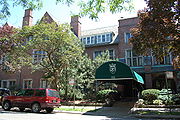.gif)
Quadrangle Club (University of Chicago)
Encyclopedia


University of Chicago
The University of Chicago is a private research university in Chicago, Illinois, USA. It was founded by the American Baptist Education Society with a donation from oil magnate and philanthropist John D. Rockefeller and incorporated in 1890...
. It is located at 1155 East 57th Street (the southeast corner of 57th Street and University Avenue) in Chicago
Chicago
Chicago is the largest city in the US state of Illinois. With nearly 2.7 million residents, it is the most populous city in the Midwestern United States and the third most populous in the US, after New York City and Los Angeles...
. It has a full-service dining room, a bar, several lounges, and sleeping quarters for members and/or their guests. It has 17 sleeping rooms, including 5 suites with an extra sitting room. It is one of the few locations in the city of Chicago
Chicago
Chicago is the largest city in the US state of Illinois. With nearly 2.7 million residents, it is the most populous city in the Midwestern United States and the third most populous in the US, after New York City and Los Angeles...
that has Har-Tru (clay) tennis
Tennis
Tennis is a sport usually played between two players or between two teams of two players each . Each player uses a racket that is strung to strike a hollow rubber ball covered with felt over a net into the opponent's court. Tennis is an Olympic sport and is played at all levels of society at all...
courts.
History
The Quadrangle Club was created in 1893 as a social club for the faculty of the newly established University of Chicago. It was to be a place to gather for "study, socialization, and especially communication," and from its inception was open to members of the community as well as to faculty. It was spearheaded by Robert Francis Harper, an associate professor of Near Eastern Languages and the younger brother of William Rainey Harper, first president of the university. It originally occupied a suite in the Barry Hotel, located at 59th Street between Dorchester and Blackstone.By 1895, the club had outgrown the hotel suite, and land was purchased for the construction of a club house on the southeast corner of 58th and University, the current site of the Oriental Institute
Oriental Institute, Chicago
The Oriental Institute , established in 1919, is the University of Chicago's archeology museum and research center for ancient Near Eastern studies.- History and purpose:James Henry Breasted built up the collection of the Haskell Oriental Museum...
. The new club house opened in 1896 and contained billiard and card rooms, a gymnasium, some sleeping rooms, and a small ladies' room for the wives of members. Outside, to the south, there were tennis courts. The Club hosted many social events, including lectures, recitals, and dances. As an afterthought, a small dining room and basement kitchen were added to the building. In 1897, fires led to modifications of the building by Howard Van Doren Shaw
Howard Van Doren Shaw
Howard Van Doren Shaw was an American architect. He became one of the best-known architects of his generation in the Chicago area.-Early life and career:...
, a distinguished architect who later designed the building that the club currently occupies.
In 1916, to make way for Rockefeller Chapel
Rockefeller Chapel
Rockefeller Chapel is, by order, the tallest building on the campus of the University of Chicago in Chicago, Illinois. It was meant by patron John D...
, the Quadrangle Club agreed to relocate to a parcel of land on the corner of 57th Street and University Avenue, the present site. Howard Van Doren Shaw designed the new building, which opened on December 21, 1922. Shaw designed a building resembling an English country house, with large open spaces and—on the second floor, facing the tennis courts—abundant natural light. In the summer of 1929, the old club house was moved (in two pieces) two blocks west to 956–960 East 58th Street, where it was renamed Ingleside Hall.
The Quadrangle Club enjoyed a golden age during the 1920s and 1930s when it functioned as a popular gentleman's club offering billiards, a card room, and stimulating lunchtime conversation. The "Round Table", a lunchtime tradition in which professors from diverse fields gathered to share ideas, flourished.
As World War II
World War II
World War II, or the Second World War , was a global conflict lasting from 1939 to 1945, involving most of the world's nations—including all of the great powers—eventually forming two opposing military alliances: the Allies and the Axis...
came to an end the Quad Club found itself redefined by the changes in the times. There was pressure to admit all faculty, including women professors. The decline of the South Side of Chicago and the attractiveness of suburban living to some faculty decreased the potential membership. It lost many amenities of the gentleman's club as financial pressures forced rooms to be taken over for catering affairs. The Club has always kept its dues and fees low to accommodate faculty members with modest incomes, and catering helped to make up the inevitable deficits.
Relationship with the university
The Quadrangle Club's relationship with the university has varied over the years as the club tried to accommodate both "town" and "gown", but it has always been close. In part to facilitate needed repairs to the building, the university took formal control of the club in April of 2007. In exchange, the university promised to rehabilitate the building and maintain the club's commitment to its members through the hiring of the outside management company Flik Conference Centers, a division of Compass Group's North American Division.While the Quadrangle Club is the University of Chicago's faculty club, university staff, parents, and neighbors are welcome to join. Roughly one quarter of the club's membership are not University of Chicago faculty or staff.

